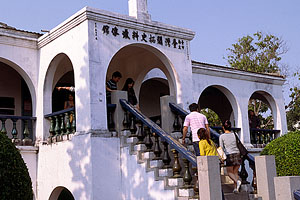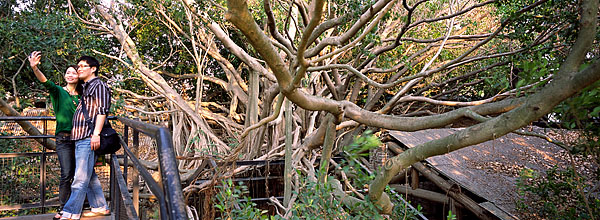Tait and Company and the Anping Treehouse
Old Tait & Co. Merchant House
The expulsion of the Dutch from Taiwan in 1662 was not the end of European traders in Taiwan nor in Anping, but it took an Opium War to officially open the doors to trade. Anping was one of the four harbors opened to foreign trading on Taiwan as per the treaty of Tianjin signed in 1858. Tait & Company opened shop in 1867 and, together with Bains & Co, Boyd & Co, Wright & Co, and Julius Mannich & Co, made up one of the five main foreign trading firms in Anping. Only the company buildings of Julius Mannich and Tait remain from this era. The Tait & Company building is well-preserved and has been made into a mini-museum.
Tait & Company dealt mostly in the trade of tea, camphor and opium. The company also handled banking and insurance. The first thirty years of business were prosperous, but the arrival of the Japanese in 1895 saw the decline of foreign trading. The Japanese government took control of all camphor and opium trade. Left only to peddle tea, foreign merchant business seriously declined. In 1911, the Japanese removed all foreign traders from Taiwan.
Under the Japanese, the Tait & Company building housed a salt company. After World War II, it became the offices for the Tainan Salt Works. Then in 1979, the building was turned into the museum you see now.
Tait & Company and the Julius Mannich & Company buildings are the only remaining merchant houses from this era. They are probably the only pieces of European colonial architecture left in Tainan. Tait and Company is a beautiful two-story structure with wrap-around verandas and arched colonnades surrounding the inner building. Many of the original wooden doors, windows, floor and roof beams remain in great condition.
The inside of this building houses a museum. It is not a museum of British trade, but rather an exhibition on early life in Taiwan around the time of the Dutch (19th century British traders, 17th century Dutch traders, it’s all the same, right?). The first floor contains a great exhibition on early settlers, highlighting lifestyles of the Dutch, the Chinese and the local aborigines. If you take the time to read all the information, you’ll probably find it an informative and a rather balanced account. The descriptions are in good English, Chinese and even some Dutch. The second floor is a wax museum that feels quite dated, but is worth a look. The depiction of Zheng Chenggong as a giant next to the surrendering Dutch is pretty amusing.
Anping Treehouse
Just next to and behind the Tait & Company building is the Anping Treehouse. While this might sound like a children’s theater, it is actually the old warehouse building for Tait & Company. After years of neglect, some banyan trees have claimed this building for themselves, making the whole building a giant brick flower pot for the foliage that pours out of the roof.
This large, brick building served as a warehouse for Tait & Company and the Japan Salt Company. When the salt industry declined after World War II, the building fell into disrepair and the banyan trees took over.
This is quite a large warehouse space and the trees are massive. It’s hard to tell where one tree ends and another begins as the root system travels along the walls like snaking ivy and the branches almost come out of nowhere. Much of the roof has collapsed, but there are still some original beams intertwined with the branches. From the outside, the thick green foliage appears to encompass the entire structure and it’s hard to see the building beneath the trees. Within the building it is dark and gloomy, giving it the feeling of an ancient ruin. Thick aerial roots climb down the brick walls, creating tree-walls on top of brick.
This building was once thought of as a creepy place, but designers moved in to gentrify the building for touristic consumption. The good news is, they did a good job. They’ve built wood and metal staircases and viewing platforms that can take you up into the trees and view the warehouse from up within the branches. The building design is minimalist and adds a lot to the experience. Into one of the rooms, they’ve built some information displays about various flora in the area. In the back of the warehouse is a viewing platform that overlooks the Yanshui River. The designers have won awards for this project.
The Anping Treehouse is a great place to do photography. It does get pretty crowded there on the weekend, so you may want to try a weekday if you want to be alone with the bricks and roots.
The Admission price includes both Tait & Company and the Anping Treehouse.
In my opinion, any first visit to Anping should start with Tait & Company. The small exhibition house next to Tait & Company contains a great overview of the Anping Harbor National Historical Park, and the museum gives a great introduction to life as an early settler. There’s also ample parking nearby and it is an easy walk to Anping Fort.
Admission: Adult: NT$50; Concession: NT$25 (includes both locations)
Hours: Monday to Sunday, 8:30AM ~ 5:30PM
Phone: (06) 3913901
Location: No.194 Anbei Road, Anping District, Tainan City







My wife’s great uncle, James Christie MASSON, founded Tait & Co. in Anping in 1867. He became ill and returned to Scotland where he died in 1873. We know very little about him. Any information would be very welcome.
I’ve never seen any information about the people who ran Tait & Co. Certainly, if I come across anything I’ll pass it on.
Hey, great stuff! Thank you for this!